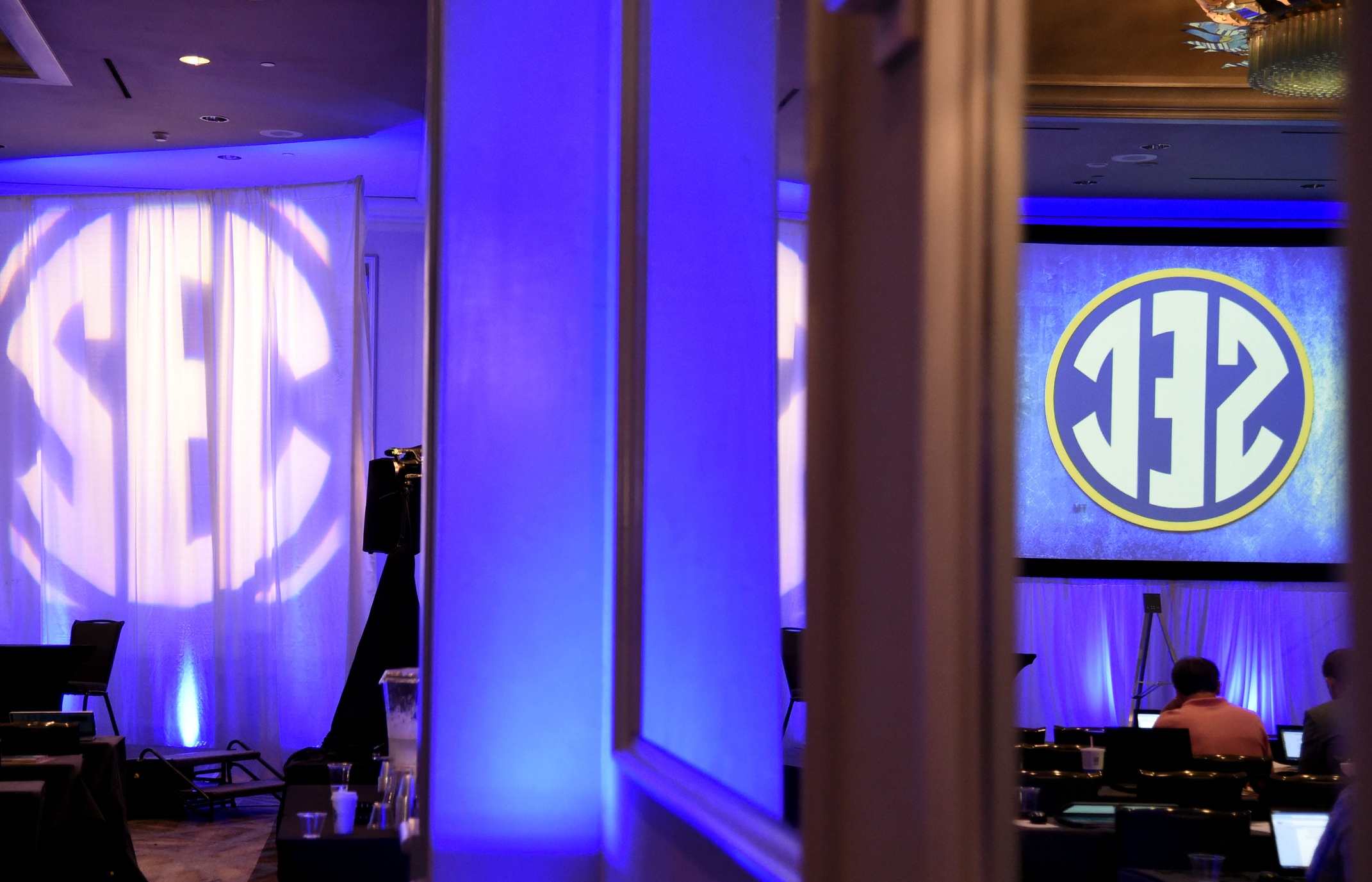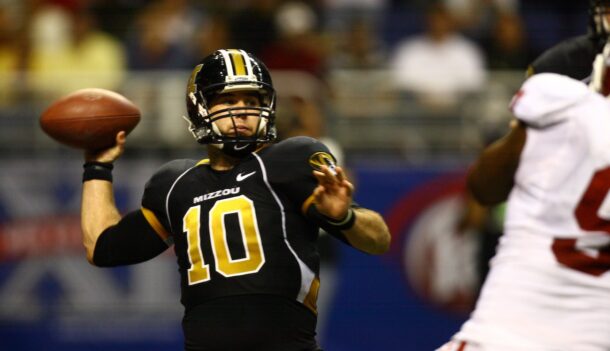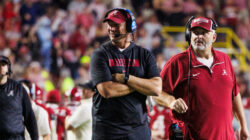
One of the reasons sports are so compelling is the unknown.
Like a real life version of a reality show, we know the characters involved. We have an idea about what they’ll all do and how they’ll behave. But the outcomes? There’s a wide range of those, and we won’t find out until later in the year.
For now, we’ve identified the best-case and worst-case scenarios for all 14 teams in 2016. (For the latter, we’ve stayed away from “handful of the best starters suffer season-ending injuries.”)
ALABAMA
Best case: Lane Kiffin molds a third consecutive first-year starting quarterback — this time it’s redshirt freshman Blake Barnett. O.J. Howard has his best season yet, Calvin Ridley avoids a sophomore slump and Bo Scarbrough becomes a suitable replacement in the Tide backfield. Without Reggie Ragland, A’Shawn Robinson, Cyrus Jones, Geno Matias-Smith and coaches Kirby Smart and Mel Tucker, the Bama defense remains stifling. Alabama remains the best team in the SEC, holds off a rising Tennessee team and wins yet another SEC title, giving Nick Saban a chance at national championship No. 6 in the College Football Playoff.
Worst case: The third time is not the charm at quarterback, putting the onus on a backfield that no longer contains Derrick Henry. Howard returns to his usual (average) production, while Ridley slumps like Amari Cooper did during his second season at The Capstone. The linebackers miss Ragland and the secondary’s rapid development under Tucker slows without him. Alabama stumbles more than once in the regular season for the first time since 2010 and fails to make the SEC title game.
ARKANSAS
Best case: The secondary returns to the form it held at the end of the 2014 season, once again turning the defense into a unit capable of dominating games. The huge personnel losses on offense are offset by the fact that coordinator Dan Enos no longer needs time to go through the growing pains that plagued the unit early last season. Drew Morgan makes a case to be considered the best receiver in the SEC, and the Razorbacks can run the ball effectively even without Alex Collins. Avoiding the early-season missteps, Arkansas threatens double-digit wins in the regular season.
Worst case: All of the roster turnover on offense leads to a regression, as the Hogs can’t come close to replicating Brandon Allen’s production at quarterback. Worse, the pass defense continues to flounder. Even the team’s running game takes a step back without Collins. Without a legitimate strength, the gritty SEC West is able to deliver too many blows, as Arkansas finishes at or near the bottom of the division.
AUBURN
Best case: Someone — anyone — emerges as a reliable option at quarterback. Preferably someone who can execute the read-option with proficiency. With a full season, Jovon Robinson becomes one of the best running backs in the SEC. Auburn once again is one of the best Power 5 running teams in the nation. Carl Lawson stays healthy for an entire season. He gets enough help from Montravius Adams and Byron Cowart on the defensive line. Even with all the coaching changes on defense, that unit improves, and the Tigers remain in the SEC West race deep into November.
Worst case: Adding John Franklin III just muddies the quarterback position even further, as Gus Malzahn has trouble choosing between him, Jeremy Johnson and Sean White. The short leash leads the quarterbacks to play while looking over their shoulders. Robinson doesn’t sustain the production he managed at the end of the season, and the team’s young pass-catchers need more time to develop. Lawson can’t stay healthy, and the turnover on the defensive coaching staff exacerbates that downside. By the end of the season, rampant speculation about Malzahn’s job is a huge distraction as the Tigers limp to another mediocre bowl.
FLORIDA
Best case: The “misfit toys” on offense start to resemble an intentional cohesive system. The offensive line, patchwork at best in 2015, gets much better, and a backfield that has been pedestrian for some time now looks dynamic on occasion. One of the veteran transfers starts at quarterback. He isn’t an All-SEC player, but with Jim McElwain’s tutelage, he’s a significant improvement from Treon Harris in the second half of last season. The defense still has enough athletes to be good even by SEC standards, and the Gators find a way to beat Tennessee once again, returning to Atlanta.
Worst case: The offensive line remains a major weakness, hampering the new quarterback and limiting the running game. Defenses are able to game plan for Antonio Callaway. Major personnel losses on Florida’s own defense further strain the team, which plays more like the second half of 2015, but for an entire season. Instead of Atlanta, the Gators don’t even finish in the top three in the SEC East, getting relegated to a minor bowl game.
GEORGIA
Best case: Jacob Eason is the best quarterback in Athens since Aaron Murray — and plays like Murray did as a freshman in 2010. Nick Chubb returns as himself, giving the team a potent, balanced offense. There are enough athletes on defense to force negative plays and takeaways. Georgia wipes out the lower half of the SEC East with ease while also getting revenge on Florida and taking down Tennessee. Kirby Smart justifies the decision to move on from Mark Richt by winning the SEC East with mostly the same talent.
Worst case: Eason needs at least a year to develop, leaving UGA without a quarterback capable of leading the team to a division title. Chubb isn’t the same player that he was before the injury, and without Malcolm Mitchell, the offense lacks a go-to receiver. The defense is decent, but not good enough to win games by itself. The move to Kirby Smart changes nothing, and Georgia finishes the regular season with 8 or 9 wins.
KENTUCKY
Best case: Mark Stoops gets the offensive coordinator hire right this time. That, along with an improving offensive line, springs the now-maturing skill players. The receivers suddenly stop dropping the ball. UK gives Boom Williams 200 carries. An unheralded secondary leads a defense that’s more competitive than most anticipate. Kentucky finally breaks through with 7 wins and a bowl appearance after beating at least one of the Big Three in the SEC East.
Worst case: The offensive line needs another year to develop, negating any positive change at quarterback and coordinator. The receivers don’t learn how to catch. The team gets beat at the point of attack on both sides of the ball. The team goes 1-2 against Vanderbilt, Missouri and South Carolina. Stoops and his staff just can’t develop the talent they’ve accrued, and after another season of missing a bowl, UK must make a tough decision.
LSU
Best case: Les Miles spearheads a bizarre rejuvenation. Just as everyone insists that the team change, it wins big by doing everything exactly the same. Leonard Fournette is the clear No. 1 running back in the country. Travin Dural and Malachi Dupre are so good that with another year of development, Brandon Harris is a decent SEC quarterback. The addition of Dave Aranda returns LSU’s defense to its dominant ways. The team exacts revenge on Arkansas and Ole Miss, winning an SEC title and making Miles as popular as ever.
Worst case: The good feelings at the end of the 2015 season and on National Signing Day dissipate quickly in the fall. Fournette plateaus as teams double-dare the Tigers to do anything but give him the ball. The defense is too thin in spots and can’t survive a few key injuries. By November, it becomes clear that nothing has changed, and perhaps the team should move on from Miles after all. That makes for a contentious and public drama that supersedes important games down the stretch.
MISSISSIPPI STATE
Best case: The offense is just fine, even without the greatest offensive line. Fred Ross is one of the SEC’s best receivers. The new quarterback plays just fine. The team’s running game revives. And everyone remembers that Mississippi State is very good at developing talent as a hard-nosed defense is good enough against the run to slow everyone but Leonard Fournette. The Bulldogs finish 9-3 with a win against Ole Miss as everyone considers it an even better coaching job by Dan Mullen than the last couple years.
Worst case: Without Dak Prescott, even Mullen, quarterback whisperer doesn’t have an adequate answer at the position. The team’s below-average SEC offensive line fails to produce its usual 1,000-yard back. The defense feels the losses of the last two years and can’t stand up to athletes at Alabama, Ole Miss and Texas A&M. Mississippi State finishes at the bottom of the SEC West as the gap between the Bulldogs and Rebels widens.
MISSOURI
Best case: All of the drama and junk that the players have dealt with in the last year galvanizes the team. With a more stable situation and help from coordinator Josh Heupel, Drew Lock develops into a promising young quarterback. All the time in the grinder early on helps churn out a few decent receivers, and a more balanced offense opens things for runners like Natereace Strong. Yet another dominant defensive line spearheads a physical unit that keeps every game close. Mizzou returns to a bowl game with 8 wins and the fans feel rejuvenated with Barry Odom as coach.
Worst case: Lock just isn’t the answer at quarterback. The team sorely misses players like Henry Josey, Russell Hansbrough and Marcus Murphy in the backfield. The offensive line is at least as weak as last year’s veteran group. All the coaching changes and a transition to a majority 3-4 alignment prevent the defense from being quite as good as it was at its peak in 2015. Missouri misses a bowl game yet again, and recruiting becomes an unenviable challenge for the new staff.
OLE MISS
Best case: Chad Kelly becomes the first SEC quarterback ever to throw for 4,000 yards in back-to-back seasons as Damore’ea Stringfellow, Quincy Adeboyejo and Evan Engram make it hard to miss Laquon Treadwell. Gregory Little starts at left tackle all year as a true freshman. The defense pulls a typical Landshark stunt, occasionally giving up yards in bulk but leading the SEC in takeaways. Ole Miss beats Alabama for a third consecutive year, but this time it survives the 12-game schedule with just one blemish. The NCAA case is resolved with minimal punishment long before the Rebels play in the SEC Championship Game.
Worst case: Alabama breaks the two-game losing streak to the Rebels in a big way. LSU is better as well, relegating Ole Miss to the middle of the pack in the SEC West. An inexperienced offensive line means that Kelly gets pounded all year, and the bad side of his personality re-emerges. Meanwhile, the NCAA levies penalties against Ole Miss that are worse than many expect, including a postseason ban for 2016 and the loss of some scholarships, curtailing some of the team’s recruiting momentum.
SOUTH CAROLINA
Best case: Will Muschamp follows through on his promise to let offensive coordinator Kurt Roper open up the offense. Lorenzo Nunez proves adept at running the spread, even if some of his passes leave something to be desired. New coaches on the defensive side of the ball are able to squeeze more out of the personnel as the group plays with aggression, giving up big plays but making some of its own. South Carolina ekes into a bowl game, but the future looks positive.
Worst case: Without Pharoh Cooper, Jerell Adams and Brandon Wilds, the offensive playmakers are an embarrassment. Nunez and Brandon McIlwain both are glorified runners playing quarterback. The defensive line fails to generate much pressure for a third consecutive season. The 2016 team isn’t better in any discernible way, and the Gamecocks are the SEC’s worst team.
TENNESSEE
Best case: Joshua Dobbs figures out how to read defenses and distribute the ball downfield to his second and third reads. That supplements the best running game in the SEC, as Dobbs, Jalen Hurd and Alvin Kamara become household names nationally. On the other side, Derek Barnett looks like an All-American and new coordinator Bob Shoop makes a physical, athletic unit even better. The Vols go 6-0 against SEC East competition and make it to Atlanta with just one loss.
Worst case: Alabama remains just a shade better, the team’s demons continue against Florida and Kirby Smart’s Georgia team proves tough. The lack of a passing game and getting too conservative in the second half again costs Tennessee in a few close games. Instead of making a push for an SEC title, UT has to settle for being a borderline top 25 team. Fans openly question whether Butch Jones is the coach to bridge the final gap in the rebuilding process.
TEXAS A&M
Best case: The quarterbacks and offensive coaches all work together. This allows the team’s receivers to flourish. Even Speedy Noil stays healthy and out of the doghouse, and everyone considers Texas A&M to have the best group of pass-catchers in the country. In his second year, defensive coordinator John Chavis makes real progress with the linebackers and secondary, while Myles Garrett leads the nation in sacks. The Aggies finish top three in the SEC West and Kevin Sumlin keeps his job.
Worst case: All the changes on offense prevent that unit from being much better than it was for most of last season, as Trevor Knight is inconsistent and the running game takes a step back. Despite a terrific defensive line, the defense makes only minor progress. Worse, Texas has a much better season with Charlie Strong. By mid-November, the Aggies are contacting Tom Herman through back channels.
VANDERBILT
Best case: After being dormant for two years, the Commodores find some semblance of a passing game. That frees Ralph Webb for his best season yet, and he becomes somewhat of a folk hero in the SEC. Derek Mason’s defense remains tough, and with a more balanced overall team, Vanderbilt challenges for a bowl berth.
Worst case: The offense can’t outscore anyone, as Webb remains the only viable option. The defense keeps the team in games, but stays on the field too long, too often. Teams like Kentucky, Missouri and South Carolina are just a little bit better, and Vandy returns to 0-8 in the SEC. The team has to decide whether it’s worth it to make wholesale changes.
An itinerant journalist, Christopher has moved between states 11 times in seven years. Formally an injury-prone Division I 800-meter specialist, he now wanders the Rockies in search of high peaks.







